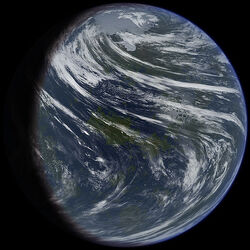
Artist's conception of a terraformed Venus.
Terraforming of Venus is the (theoretical) process of engineering the global environment of the planet Venus in such a way as to make it suitable for human habitation. There is considerable debate as to whether or not terraforming Venus is possible. The existing environment of Venus would require four major changes to the planet:
- Reducing Venus's 450°C (850°F) surface temperature.
- Eliminating most of the planet's dense 9 MPa (~90 atm) carbon dioxide atmosphere, via removal or conversion to some other form.
- Addition of breathable oxygen to the atmosphere
- Addition of water, since there is barely enough water vapor to cover the planet in a few centimeters thick layer of liquid water even if the planet is cooled.
These goals are closely interrelated, since Venus's extreme temperature is due to the greenhouse effect caused by its dense carbon-dioxide atmosphere. In addition, it would also be desirable to establish a day/night light cycle shorter than Venus's current solar day which is equivalent to 116.75 Earth days.
An alternate method of making Venus habitable involves putting habitats in the upper atmosphere.
One way to achieve this would be to smashing water-rich objects into Venus, possibly chunks of ice from Ganymede or Europa. That would add water as well as throwing up cooling dust that imitates a nuclear winter. That cooling would allow the vaporized water to start raining, creating seas and dissolving carbon dioxide. If the seas get deep enough, the pressure at the bottom will make the carbon dioxide there denser than water, trapping it and eventually pressing it into the mantle. Nearer the surface, seltzer levels can be decreased by limeing. The cooling would make the crust less bendy and sticky, in combination with the formation of sea pressure allowing for plate tectonics (the impacts themselves would produce the necessary cracks). The impacts can be coordinated to increase the spin of Venus, making its days shorter (they would still be longer than on Earth, but the shortening could still help the formation of a magnetic field for long term retention of the water). Then remains the oxygenization and ozone formation.
| This page uses Creative Commons Licensed content from Wikipedia (view authors). | 
|